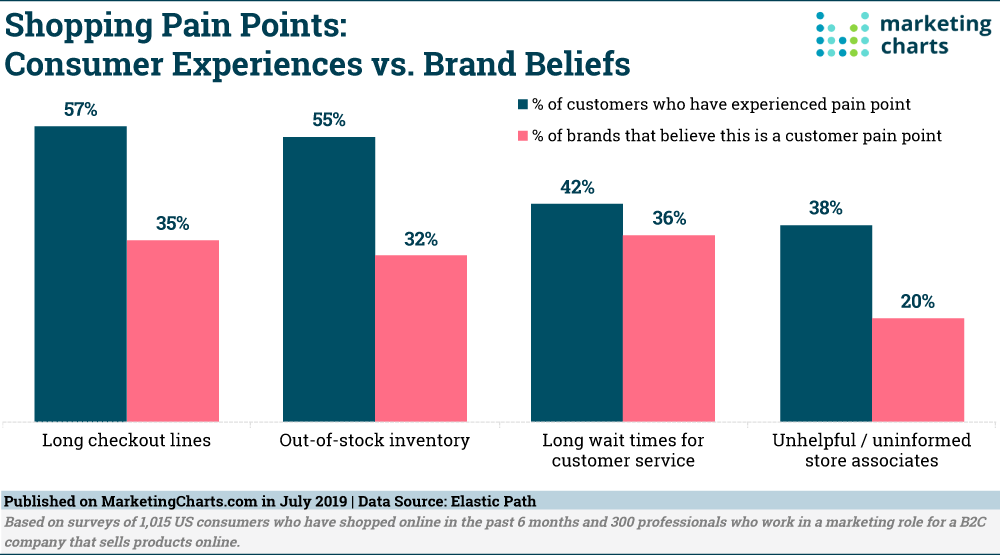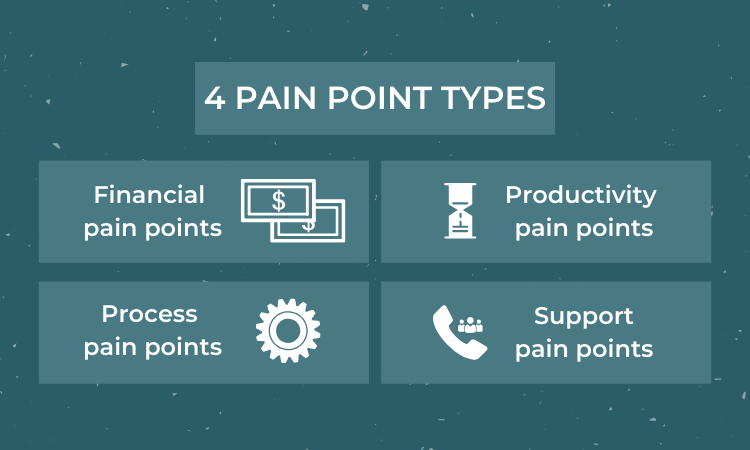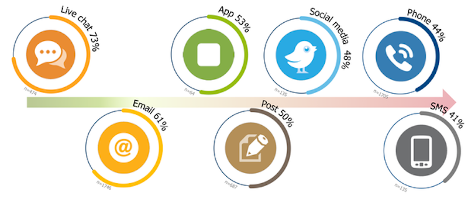How do you convert prospective customers into buying customers? This is a question that every business needs to answer. Marketers and sales reps do their best to convert prospective customers, but it’s impossible to get a 100% success rate. To increase the likelihood of conversions, your business can (and should!) address customer pain points.

Customer pain points don’t cause physical pain, but you get the idea.
In addressing pain points, you increase the chances of customers having positive experiences with your business. You offer solutions to problems they face in the market, with your competition, or with your business itself. Addressing customer pain points increases your ability to build customer relationships and promote trust in your business. This will positively impact your sales and revenue.
In this post, we’ll cover:
- What customer pain points are.
- How to identify customer pain points.
- How to address customer pain points.
What Are Customer Pain Points? Do They Matter?
Customer pain points are problems that your prospective customers face when interacting with your business. These problems can vary and addressing them will impact the way your business deals with sales or marketing. You must find appropriate ways to deal with pain points as they can directly impact your bottom line.
Here are a few common customer pain points you may recognize:
- Difficult website navigation.
- Being hard to contact.
- An awkward checkout process.
- Price and availability of a product or service.
It can be easy to address pain points, but it is challenging to discover them. Often, businesses are oblivious to the pain points that customers face on a daily basis.

As you can see from this chart, more customers have experienced these pain points than brands realize.
Businesses offer solutions to various problems customers face. Their products fit certain customer needs within the market. Yet, marketers and business owners don’t know what prevents a customer from adopting their solutions. For example, why would a customer not adopt window cleaning services? Finding the answer could help them tailor successful campaigns.
How to Identify Customer Pain Points
To identify problems customers face, you need to know more about them. It’s impossible to run a “flawless” operation, but a business can always make improvements. To do this, you can probe customers or your employees who engage with them. This enables you to discover the challenges customers face in interacting with your business.
Collect Data & Act
You can gather data on customers using website cookies, data analytics, and first-party data.

As customers interact with your business or brand across numerous touchpoints, focus on customer journey analysis using multiple channels. Using data, you can gain key insights that will allow a business to improve customer experience across all of its channels.
Using data for customer journey analysis enables you to know more about your customers. This way you will avoid customer profile mistakes. You also gain insights into the behavior and motivations of customers.
Survey The Competition
In every niche, numerous competitors are vying for customer attention. By watching other businesses, you uncover problems that need to be solved. When creating products and services, we often assess other similar products and ways to improve them. Similarly, marketers can analyze the content and marketing strategies of competitors in their niche.
Watching the competition enables you to do market research and see how others address customer pain points. This tactic offers a wider view of audiences that you and other businesses are attempting to serve. Different people use different solutions. Like people, businesses have different tactics to address a customer’s challenges. Get that holistic view of the market and improve your operations.
Gather Customer Feedback
Customer feedback is a valuable resource to a business. It allows you to ask customers about their experience with you. You can uncover the challenges they face by asking them the right questions directly. Create short questionnaires and surveys, then ask questions that will give the clearest answers. Here are 21 customer feedback questions to help you get started.

Review sections on your website or near your products can also help a business understand a customer’s experience. Some customers leave thorough review points about positive and negative aspects of their experience with a business. Using this information you can address their pain points and improve your service.
Gather Sales/Support Agent Feedback
Sales and support agents interact with prospective or current customers daily. As such, they are listening to customer feedback on your products every day. Sales agents pitch products to customers and get to gauge the customers’ interest levels based on their responses. By having regular review sessions, your sales agents can highlight reasons why customers opt not to make purchases.
Similarly, support agents listen to a wide range of customer issues every day. Support agents talk to current customers about your products and other aspects of the customer’s experience. Here your business can uncover customer pain points. Having review sessions will allow customer support agents to put forward challenges current and prospective customers may face with your business.
How to Address Customer Pain Points
Below are examples of common customer pain points with our tips to address them.
Research Pain Points
Customers will often research information on products before making purchases. With all the available information online, it is easy to get lost and uncover incorrect information (like on your local listings).

You can start your research by looking at these common customer pain point types and analyzing how your business stacks up in each category.
Give your sales and customer support agents the most relevant information on your products. Make it easy for customers to find accurate information. You could refresh the FAQ sections on your website and write authoritative blog posts on pertinent questions like, “How does a VoIP phone system work?” Customers will appreciate you when they can conveniently research your products and find accurate information.
Website Pain Points
What if your business offers quality services like remote work tools? Excellent products are offset when the business website creates pain points. It’s well known that technical errors and poor user experience can lead to a website having higher bounce rates than expected. Customers may find a website or self-service support difficult to navigate or confusing to explore.
Put some focus on creating the best possible business website. Use analytics and cookies to see how customers interact with your website. With that information, you can update your site with customer experience in mind.

This website is easy to navigate and makes it simple for patients to request an appointment.
Customers should have a smooth and simple experience when navigating your business website.
Customer Support Experience
Customer support encounters can be a source of discomfort or genuine pleasure. That depends on how well a business manages its customer support operations. Due to a variety of reasons, customer support experiences can easily become pain points for current and prospective customers.
They say happy employees create happy customers. A business should do its utmost to keep sales and support agents happy at work. They will be more polite and attentive to customer problems. Have a plan to navigate bad customer experiences for those more challenging customer interactions. Find ways to improve on customer interactions across all channels and acknowledge areas that aren’t quite right.

Make sure you’re communicating with customers in the way they prefer. The majority prefer live chat over other forms of support.
Related: Get quick tips to improve customer communications.
By addressing pain points faced with customer support, your business will simultaneously build customer relationships. Your business shows that it values its customers by lowering call hold times, offering pleasant interactions, and listening carefully to customer problems. This will lead to happy customers that could become advocates on your behalf.
Financial & Logistical Pain Points
Customers need to know how much a product or service is going to cost. To avoid seeming misleading, prices should be straightforward and clear with additional information when required. A business usually provides customers with the necessary details surrounding their prices, e.g. taxes, delivery, etc. However, the customer is not overly interested in reading a complicated price list or invoice.
For a business trading on e-commerce platforms, you will need to provide information on availability, delivery speed, and delivery costs. It’s e-commerce 101 to use the best inventory management software to manage your product stocks. Customers will appreciate it when they find real-time inventory updates across all your sales channels.
After making an online purchase, have you ever felt anxious about what happens next? You want to know if the order went through, if a product was dispatched, and whether it’s lost in the post.

All these thoughts cross the mind soon after checkout. Your business will want to use software that automatically updates customers on their purchases. This will build trust between your business and customers.
Addressing Customer Pain Points Puts You Ahead
You may uncover similar customer pain points, but none are identical. Every customer faces their own set of challenges. The solutions a business finds to these problems can propel them into an excellent position in the market.
By addressing customer pain points, your business will improve its reputation and the experiences customers will have interacting with it. Use the data, talk to customers, and get your marketing and sales staff on the same page. At the end of it all, improve on customer experience to make your customers happy and reap the rewards.
About the Author
Richard Conn is the Senior Director, Search Marketing for RingCentral, a global leader in unified communications. He is passionate about connecting businesses and customers and has experience working with Fortune 500 companies such as Google, Experian, Target, Nordstrom, Kayak, Hilton, and Kia. Richard has written for sites such as VoilaNorbert and DataFeedWatch.






